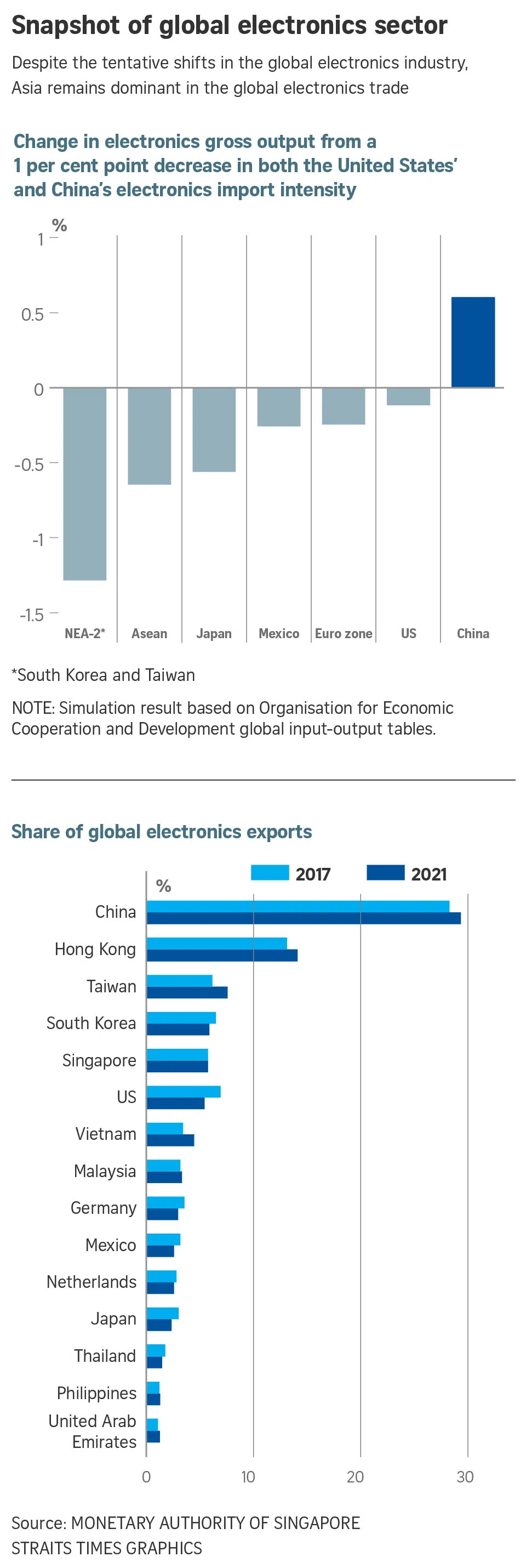Falling demand from advanced economies clouds Singapore’s 2023 growth outlook: MAS
Sign up now: Get ST's newsletters delivered to your inbox

In Singapore, core inflation - which excludes accommodation and private transport costs - has peaked, said MAS.
ST PHOTO: LIM YAOHUI
Follow topic:
SINGAPORE – The Republic’s growth prospects have become more uncertain as demand weakens for its key electronics exports from the advanced economies of the United States, euro zone and Japan, the Monetary Authority of Singapore (MAS) warned in a report.
China will be a notable exception among major economies as its growth is set to rebound after the end of Covid-19 curbs,
However, beyond tourism, the boost from China’s reopening to exports from Asia and Singapore is projected to be relatively muted, added MAS.
The outlook for Singapore’s financial sector has also weakened amid rising interest rates and turbulence in the US and European banking sectors, the central bank said, referring to the collapse of Silicon Valley Bank and Credit Suisse.
MAS also warned that the reconfiguration of supply chains amid US-China trade frictions poses a threat to the growth of the global tech industry and, by extension, to Singapore’s electronics sector.
The sector accounts for 42 per cent of Singapore’s manufacturing output and 10 per cent of nominal gross domestic product (GDP).
Weaker economic activity will, however, quicken the decline in inflation worldwide, though prices are still rising at a pace faster than most central banks would like and hence interest rates will remain high, MAS said.
In Singapore, core inflation, which excludes accommodation and private transport costs, has peaked
Singapore’s imported inflation, which has already turned negative, should fall further alongside lower commodity prices and the stronger trade-weighted Singapore dollar, after five tightening moves by MAS between October 2021 and October 2022.
MAS believes that inflationary pressure will also weaken as the tightness in the domestic labour market eases, moderating wage growth. It expects core inflation to fall as low as 2.5 per cent by the end of 2023, bringing the annual average to between 3.5 per cent and 4.5 per cent.
The central bank stood by its forecast for Singapore’s economy to grow between 0.5 per cent and 2.5 per cent this year, but warned of risks.
“A broadening downturn in the global electronics industry and the recent banking stresses in the US and Europe have dampened Singapore’s growth prospects, given its relatively large exposure to the tech and finance sectors,” MAS said.
The global manufacturing and trade slowdown, especially in electronics, that started in late 2022 has intensified at the start of this year, and economic growth for most of Singapore’s trading partners is likely to trend lower this year.
MAS said growth in the US, euro zone and Japan – referred to as G3 – will ease to 0.6 per cent in 2023 from 2.4 per cent in 2022. The Asean-5 – Indonesia, Malaysia, the Philippines, Thailand and Vietnam – will grow by 4.6 per cent, down from 5.8 per cent in 2022.
It said economic activity is expected to slow worldwide over the coming quarters, as the rapid and simultaneous tightening in global monetary policy filters through to the real economy.
Higher global interest rates have also unearthed latent vulnerabilities within the financial system, and their recent manifestation in bank failures presents risks to global financial stability and the growth outlook, MAS added.
It said Singapore’s banking system appears to be well insulated from the shock. Still, the high interest rate environment will continue to exert a broad-based drag on the financial sector in the coming quarters.
“Credit demand is likely to weaken while the stock of loans could also shrink further as corporates look to reduce interest expenses by repaying loans earlier,” MAS said.
Assessing the impact of US-China frictions on trade and investment flows in the global electronics supply chain, MAS noted that some reconfigurations through trade diversification and insourcing are already evident.
“Despite these tentative shifts in the global electronics industry, Asia remains dominant in the global electronics trade, accounting for two-thirds of the world’s final electronics exports and 85 per cent of its intermediate electronics exports in 2021,” MAS said.
However, it estimates that the US and China together accounted for more than 70 per cent of total semiconductor investments in 2021, underpinned by domestic investments amid the push for greater insourcing.
This insourcing trend could intensify over time, as seen by direct investment flows.
“Greater insourcing among the US and China could have an adverse impact on electronics and overall output in the rest of Asia,” it said.
Still, MAS concluded that a more fragmented electronics global value chain (GVC) presents both challenges and opportunities for Singapore.
The country has maintained its share of around 6 per cent in global electronics exports from 2017 to 2021, and was the fifth-largest electronics exporter worldwide in 2021.
“While the G3 has stepped up competition for investments in advanced chipmaking activities, Singapore has continued to draw investment interests, including from firms in mature technology nodes which remain the critical backbone across the electronics GVC.”
To navigate the increasingly narrow and fragmented electronics trade corridors, MAS said Singapore could strengthen and entrench its role as an entrepot hub, by leveraging its geographical advantage and efficient trade logistics ecosystem.
“With the rising importance of Asean and India particularly in assembly, testing and packaging activities, it could be desirable for upstream producers in Singapore to forge stronger links with these emerging nodes in the electronics GVC.”
In addition to trade, Singapore would also benefit from the growth potential in the new emerging nodes by seeking a greater role in capacity investments in these economies.
Said MAS: “Maintaining Singapore’s relevance in the major electronics trade corridors will not only ensure long-term growth in the manufacturing sector, but also generate positive spillovers to the services sectors such as wholesale trade, transportation, finance and insurance and professional services.”



